

 As the second World War approached its end, hopes ran high among the
leaders of the Zionist movement that the British government would amend
its policy towards Jewish immigration to Eretz Israel. Such hopes, however,
were soon dashed. In the summer of 1945, a general election was held in
Britain. Labor pledged that if they were returned to power, they would
revoke the White Paper and permit Holocaust
survivors to immigrate to Eretz Israel without delay. They also promised to
act for the establishment of a Jewish national home in Eretz Israel, which
would gradually evolve into an independent state.
As the second World War approached its end, hopes ran high among the
leaders of the Zionist movement that the British government would amend
its policy towards Jewish immigration to Eretz Israel. Such hopes, however,
were soon dashed. In the summer of 1945, a general election was held in
Britain. Labor pledged that if they were returned to power, they would
revoke the White Paper and permit Holocaust
survivors to immigrate to Eretz Israel without delay. They also promised to
act for the establishment of a Jewish national home in Eretz Israel, which
would gradually evolve into an independent state.
However, after sweeping victory at the polls, the new Labor government soon declared
that there would be no changes in Britain's foreign policy, nor would any concessions be
granted with regard to Jewish immigration. Labor's attachment to the White Paper greatly
disappointed Jewish leaders in Eretz Israel and the Diaspora. On September 23, 1945, Moshe
Sneh, head of the Haganah General Headquarters, cabled David Ben-Gurion (then in
London) as follows:
Ben-Gurion replied swiftly on October 1: (from the Slik No.1, 1991, Haganah Archives)
The two rival factions [Irgun and Lehi] should be invited to collaborate on
condition that there is uniform authority and that total discipline is observed.
Constant effort is required to ensure solidarity within the Yishuv and, above all,
among the fighters, for the sake of the struggle.
Our
reaction should be constant, bold and calculated for a considerable period...
Sneh regarded Ben-Gurion's letter as a warrant for the launching of military action against
the British. As a first step, the Season was suspended, and
discussions initiated on collaboration between the Haganah, Irgun and Lehi. The
negotiations were crowned with success, and at the end of October, 1945, an agreement
was signed between the three organizations for the establishment of The United Resistance. The following are the main points of the agreement: (Menahem Begin, 'In the Underground' vol.2, p.7)
The leadership of the United Resistance consisted of two representatives of
the Haganah (Yisrael Galili and Moshe Sneh), an Irgun representative (Menahem Begin) and a Lehi representative
(Nathan Yellin-Mor). It held general discussions, and the Irgun and Lehi were
required to submit all plans of action to this body.
Operations were authorized by the Haganah command, after discussions between the
senior operations staff: Yitzhak Sadeh (Palmach commander), Eitan Livni (Irgun's chief operations officer) and Yaakov Eliav (Lehi's chief of operations). Later, Eliav
withdrew from these meetings and asked Eitan Livni to represent him. The Haganah
command had the right to veto plans on operational, political or other grounds.
In November 1, 1945, the three organizations conducted their first joint attack, the "Night
of the Trains". That night, Haganah units sabotaged some 153 spots along railway tracks
throughout the country, and blew up patrol launches in Jaffa and Haifa ports, while a joint
Irgun-Lehi unit, commanded by Eitan Livni, attacked the main railway station at Lydda.
This operation had a strong impact in Britain. The newspapers published detailed articles
on the acts of sabotage, and the government hastened to denounce the perpetrators. The
Jewish Agency, in a special statement issued in London, declared, inter alia:
THE SECOND EXPLOSION AT THE BRITISH INTELLIGENCE OFFICES
Once again, it was demonstrated that nothing could stand in the way of the acumen and daring of the Jewish underground. The success was overshadowed, however, by the death
of Zvi Aharoni - fatally injured in the attack; and the wounding of Yaakov Granek (later known as 'blond Dov'), both of Lehi. Seven British policemen lost their lives in the explosion and a large number were injured.
At the same time the district headquarters of the police and the British Intelligence office in Jaffa were housed in a four-storey building on the Jaffa-Tel Aviv Road were attacked. The force, led by Eliyahu Tamler (Yehoshua), approached the building under cover of darkness and succeeded in setting an explosive charge. Several minutes
later the second storey of the building, housing the British Intelligence was destroyed.
That night, another Irgun unit, under Amichai Paglin
(Gidi), attacked the army camp at the Exhibition Grounds in north Tel Aviv. In the exchange of fire, a British soldier was killed. An Irgun fighter, Dov Sternglass, lost his life, and five other fighters were injured.
THE 'NIGHT OF THE AIRFIELDS'
After the war, Palestine became an important center of activity for the RAF (Royal Air Force), and aircraft of various types were stationed here. These aircraft were natural
targets for the underground. On the cold, rainy night of February 25, 1946, a combined operation took place: a Lehi unit attacked the airfield near Kfar Syrkin and set eight
aircraft ablaze. At the same time, an Irgun unit made its way on foot to Lydda airfield, seven kilometers from Kfar Syrkin. The British had installed a powerful searchlight on the
control tower, which illuminated the airfield and the perimeter fences. In the center of the field were two guard tents, from which armed Bren-carriers patrolled the area. Moreover,
the RAF garrison was housed in barracks across the road from the airfield, and the personnel were on constant alert against intruders.
The Irgun unit arrived at the airfield behind schedule, and as the men approached the fence, they heard from afar the echo of the explosion at Kfar Syrkin. Although they feared
that the British might have had time to prepare an ambush, Dov Cohen (Shimshon), the commander of the operation, decided to proceed according to plan. One of the squads crept cautiously up to the nearby transformer, and a loud explosion plunged the entire airfield into darkness. The alarm was sounded, summoning the British troops to their positions, but the Irgun fighters cut the barbed wire, advanced under cover of darkness and attached explosive charges to the
aircraft. Another squad directed heavy fire at the barracks, preventing the RAF troops from emerging. After the charges had been detonated, the strike unit withdrew to the
rendezvous point, and the entire force proceeded on foot through the muddy fields to the orange groves of Petah Tikva and Ramat Gan. The next day, it became known that the raid
on Lydda airfield had destroyed 11 military aircraft.
While Shimshon and his men were proceeding towards
Lydda airfield, two trucks were making their way from Rehovot to the military airfield at Kastina (present day Hatzor). The first truck was loaded with weapons and explosives,
which were covered with straw and crates of vegetables. Twelve fighters, disguised as Arabs, were seated on the crates. The other fighters were in the second truck, dressed in
work-clothes, like moshav farmers returning home from the field. The trucks halted not far from the airfield, weapons were allotted and the force, led by Amichai Paglin (Gidi), advanced on foot towards the target. They
reached the airfield perimeter fence without being spotted, and cut the wire silently. The sappers slipped through the fence, and ran swiftly towards the aircraft. Using ladders they
had brought with them, they positioned the charges on each plane between fuselage and wing. After setting the time fuses, they withdrew to the meeting point. The RAF personnel on the airfield were prevented from leaving their barracks by the machine-gun fire of the covering unit. While the fighters were re-assembling outside the airfield, there were loud explosions as some twenty military aircraft went up in flames.
THE DEATH SENTENCE

...it has been proposed that we stage a grave incident. Then we
will issue a statement declaring that this is only a warning, and
hint at much more serious incidents to follow.

[...] We must not confine our reaction in Palestine to immigration and
settlement. It is essential to adopt tactics of S [sabotage] and reprisal. Not
individual terror, but retaliation for each and every Jew murdered by the White
Paper. The S. action must carry weight and be impressive, and care should be
taken, insofar as possible, to avoid casualties...

a. The Haganah organization has entered upon a
military struggle against British rule.
b. The Irgun and Lehi will not implement combat plans
without the approval of the command of the United Resistance.
c. The Irgun and Lehi will carry out combat missions
assigned to them by the command of the United Resistance Movement.
d. Discussions of proposed operations will not be
formal. Representatives of the three fighting organizations will meet regularly,
or whenever the need arises, and will discuss such plans from a political and
practical viewpoint.
e. Once operations have been approved in principle,
experts from the three organizations will clarify the details.
f. The need to obtain the consent of the United Resistance command does not apply to arms' acquisition (i.e. confiscating
weapons from the British). Irgun and Lehi have the right to conduct such
operations at their discretion.
g. The agreement between the three fighting
organizations is based on 'positive precepts'.
h. If, at some time, the Haganah should be ordered to
abandon the military struggle against the British authorities, the Irgun and Lehi
will continue to fight.


It is a tragedy that matters in Palestine have reached such a pass.
The Jewish Agency abhors the use of violence as a weapon in the
political struggle, but realizes that its ability to impose restraint
has been severely tested by the continued policy (of the British
government), which the Jews regard as fatal for them.
Whilst this statement did not constitute an endorsement of the operation, it did mark the first occasion on which the Jewish Agency expressed sympathy for its underlying motives.
Nearly two months later, on December 27, 1945, a joint Irgun-Lehi force, led by Shraga Alis, launched an assault on the British Intelligence offices in Jerusalem for the second time. The British had learned the lesson of the first attack (March 23, 1944), and had introduced special
security arrangements in the Russian Compound in Jerusalem; despite these, however, the underground fighters succeeded in evading the British patrols, entered the building and set
the explosive charges. The central British Intelligence building collapsed.
A poster published by the
Irgun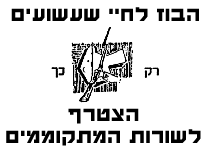
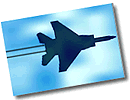 One of the most impressive operations conducted by the United Resistance was the joint assault on three military airfields. As noted above, the Irgun had refrained from
striking military targets while Britain was still fighting the Germans. However, once the war was over, the restrictions no longer applied, and the British army, which had played
an active part in harrassing the Yishuv, was no longer exempt from attack by the underground.
One of the most impressive operations conducted by the United Resistance was the joint assault on three military airfields. As noted above, the Irgun had refrained from
striking military targets while Britain was still fighting the Germans. However, once the war was over, the restrictions no longer applied, and the British army, which had played
an active part in harrassing the Yishuv, was no longer exempt from attack by the underground.
 The force retreated through the orange groves, and after fifteen minutes or so, a single shot rang out. One of the fighters, Nazim Ezra Ajami (Yehonatan), was hit and died soon after. He was the sole victim of the widescale operation that night.
The force retreated through the orange groves, and after fifteen minutes or so, a single shot rang out. One of the fighters, Nazim Ezra Ajami (Yehonatan), was hit and died soon after. He was the sole victim of the widescale operation that night.
A poster published by the
Irgun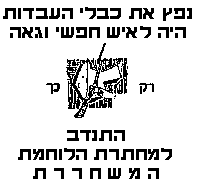
On March 6, 1946 at 1.30 pm, a military truck carrying 30 Irgun fighters disguised as British soldiers approached the Sarafand army camp. While the "officer" seated beside the driver was handing over the documents to the guard, several fighters climbed down from the truck. They easily overcame the guard and the five other soldiers who were on duty in the guard tent. The truck hastened to the armory, and the "soldiers" began loading crates of weapons onto the vehicle. While they were engaged in this task, a British soldier returned from his lunch break, his suspicions aroused by the unusual activity. He opened fire and was joined by other soldiers. In the exchange of gunfire, five fighters were injured, two of them, Yosef Simchon and Michael Ashbel, seriously. The truck, loaded with the fighters and the crates of weapons, drove off at high speed, but not before the commander of the operation, Eliyahu Tamler (Yehoshua) had detonated a mine, which blew up the remaining weapons and ammunition in the armory. The truck halted at Rishon Lezion, where the wounded were given medical treatment and the weapons were unloaded in the dunes. The lightly-injured slipped away with the other fighters, while Simchon and Ashbel were loaded into a car escorted by Shulamit Shmueli and Zippora Flumin (who had been on duty at the first-aid station). The driver took off for hospital in Tel Aviv. On the way they were intercepted by a British armored car, and the soldiers searched the vehicle and arrested the passengers. The two injured men were taken to Jaffa jail and, after interrogation, were transferred to a government hospital, where they underwent surgery. The two women were taken to the women's jail in Bethlehem, where they remained until the British evacuation of Palestine.
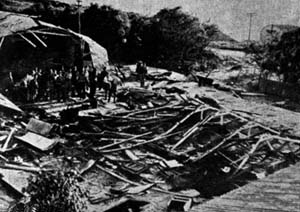
Sarafand armory
| [...] You cannot break the spirit of the Jewish people nor can you destroy the desire for freedom which fires the hearts of its sons. And my proclamation, made in this place, will serve as one more testimony - one of many - to the indomitable stand of six hundred thousand Jewish citizens, who are united in the struggle for the liberation of their country from the bloody rule of the British (Statement of Michael Ashbel) |
The military tribunal sentenced Simchon and Ashbel to death by hanging. After hearing their sentence, the two rose to their feet and sang Hatikva, together with the Jewish reporters in the courtroom. Kol Zion Halohemet (The Voice of Fighting Zion, the clandestine Irgun broadcasting station) broadcast the following warning:
 If you hang our captive soldiers, then, as God is our witness, we will break your gallows. We will give you gallows for gallows.
If you hang our captive soldiers, then, as God is our witness, we will break your gallows. We will give you gallows for gallows.
|
On June 18, 1946, Irgun fighters were despatched to seize British hostages, in order to save the lives of their comrades who had been sentenced to death. In Tel Aviv, two units
raided the Gat Rimon and Hayarkon hotels, where British officers were billeted. In both cases, they encountered a large number of officers; they chose the five most senior among
them and took them to a pre-designated hiding place. The British army conducted widescale searches of Tel Aviv and its environs, without success. In the end, the officers were released and the High Commissioner commuted the death sentence to life
imprisonment.
THE SABOTAGING OF THE RAILWAY TRACKS IN THE SOUTH
The Irgun force, which was dispersed over an area of forty five kilometers, was divided into three groups: the northern force, under Menahem Schiff (Zeev), assembled at a packing house in an orange grove in Rehovot and proceeded from there to the Arab village of Yibne. When they reached their destination, the sappers laid explosive charges around the supporting pillars of the bridge and, after igniting the fuses, withdrew rapidly. Shortly afterwards, there were several explosions and the bridge collapsed into the wadi.
Another unit advanced towards the railway station, and while they were engaged in blowing up various installations, a British unit arrived and opened fire.
The two other units assembled in another packing house, also in the Rehovot area. After being briefed, they boarded two trucks. As was the case at Kastina , the first truck carried
unarmed fighters posing as workers returning from the field, while the second truck was loaded with oranges. "Arab workers" were seated on the oranges, with the weapons concealed under the fruit. The convoy moved southward, and halted at the pre-arranged spot (not far from Kibbutz Yavneh). The oranges were discarded, and the weapons taken out and distributed. The force now split in two: one unit (the eastern force) moved towards Zarnuga (between the Arab villages of Yibne and Ashdod), while the second (southern) force headed for the railway station near Ashdod.
The three units were co-ordinated only as regards the hour of the attack, timed for 8 pm. The eastern force (under Eliezer Pedatzur) was delayed en route; as it approached the target, the fighters heard the explosions from the direction of Yibne. The guards greeted the oncoming force with a volley of flare rockets, which impeded their progress. They split into several squads, which dispersed over the terrain, placing explosive charges under bridges and water conduits and beside the tracks and telephone poles. One of the squads came under fire from the guards, and Ezra Rabia was severely injured. After detonating the devices, the squads assembled at a meeting point on a nearby hill, and the entire force withdrew across the dunes to Bat Yam, 25 kilometers away. Rabia was carried on a stretcher, while another fighter, injured in the arm, managed to walk with the help of a comrade. Rabia lost consciousness, and died shortly afterwards. He was buried in the dunes, on the assumption that the British would find the body the next day and give him a proper burial in a nearby settlement. His comrades stood in silence beside the grave and one of them recited Kaddish (the prayer for the dead). The next day the British found Rabia's body and burried him at Kfar Warburg under the name of "Avraham Ben
Avraham".
The fighters continued to march through the dunes and reached Bat Yam in the early morning hours, where they handed in their weapons and dispersed. The wounded man was transferred to a maternity hospital in Tel Aviv, which was temporarily treating Irgun casualties.
The southern force, under Dov Cohen (Shimshon), also reached Ashdod behind schedule.
The unit which attacked the bridge encountered resistance from the guards, who took up defensive positions in the pillbox. In the exchange of gunfire, two policemen were killed.
After setting the charges, the force proceeded to the railway station, overcame the five police guards and the station staff, and placed explosive devices beside various installations. They also blew up an engine, which happened to arrive. When their mission was completed, they set out for their home base. The trek through the sand-dunes was difficult, and progress was slow. It was already dawn as they approached Bat Yam and a
British reconnaissance aircraft spotted them. Shortly afterwards, British troops poured into the area and surrounded the weary fighters. In the ensuing battle, Avner Ben-Shem was
killed and four other fighters were injured.
Thirty-one fighters in all were arrested by the British in the Bat Yam dunes, among them some of the Irgun's best commanders. The mass arrest was a severe blow to the Irgun's fighting force, but at the same time the detention of so large a number of the underground made a strong impression on the local and international media.
HAGANAH ACTION
The acme of Haganah activities was the destruction, in one night, of 11 bridges linking Palestine to the neighboring countries. The operation on the night of June 17, which became known as "The Night of the Bridges", was the largest the Haganah launched within the framework of the United Resistance, and
was also its final one. All four Palmach battalions (the Haganah elite units) took part in the action, stationed on all the country's borders: north, south and east. The operation achieved
its objective, and the country was cut off from all its neighbors.
After the Night of the Bridges, Oz, the illegal publication of Achdut Haavoda (one of the socialist parties), wrote:
On the night of April 2, 1946, the Irgun conducted a widescale operation with the aim of immobilizing the railway network in the south. It was the largest operation the organization had ever planned, with about 100 participants. The same night, the Lehi blew up the Naaman bridge south of Acre.
 The Irgun force returned fire and three British soldiers were injured. After completing its mission, the Irgun unit withdrew to the sand dunes south of Rishon Lezion, the arms were cached away, and the fighters dispersed to their homes.
The Irgun force returned fire and three British soldiers were injured. After completing its mission, the Irgun unit withdrew to the sand dunes south of Rishon Lezion, the arms were cached away, and the fighters dispersed to their homes.
 Among those arrested was Eitan Livni, the Irgun's chief operations officer He was
sentenced, together with his comrades, to 15 years imprisonment, but two years later, was freed in the Acre jail break. He was sent clandestinely to Europe to organize action against
British targets there, and on May 15, 1948, he returned home to take part in the struggle aganst the Arab invaders.
Among those arrested was Eitan Livni, the Irgun's chief operations officer He was
sentenced, together with his comrades, to 15 years imprisonment, but two years later, was freed in the Acre jail break. He was sent clandestinely to Europe to organize action against
British targets there, and on May 15, 1948, he returned home to take part in the struggle aganst the Arab invaders.
A poster published by the
Irgun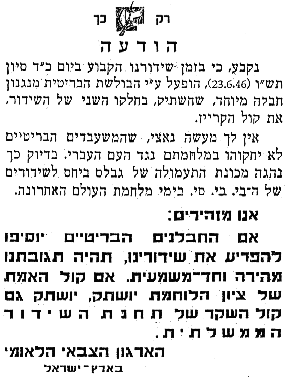
While Irgun and Lehi fighters were attacking military targets, the Haganah confined itself, initially, to assaults on targets connected with immigration. It attacked the coast guard stations at Givat Olga and Sidni Ali (near Herzliya), and blew up radar installations at Haifa. But as the armed struggle against the British gathered momentum, the front was extended to encompass military targets unconnected with immigration. On February 23,
1946, for example, the Haganah raided the mobile police force at Kfar Vitkin, Shfar'am and Sarona (now the Kirya in Tel Aviv).

The recent operations attest to the fact that the struggle has reached a more acute stage; these were no longer mere cautionary acts. They were intended to cause real damage to the authorities, and such damage was indeed inflicted. They were aimed at immobilizing transportation between this country and its neighbors, and it was in fact suspended. These activities have demonstrated that as long as there is no Zionist solution for this country, the government will not be able to rule .
next: Black Sabbath

